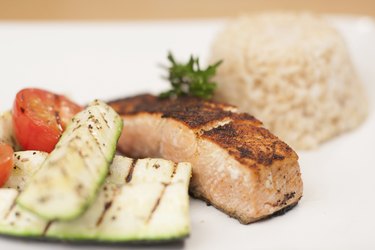
A low-fat, high-protein diet may help you lose weight, reported a study conducted by researchers at the University of Washington School of Medicine and published in 2005. In the study, subjects who obtained approximately 30 percent of their daily calories from protein, 50 percent from carbohydrates and 20 percent from fat lost an average of 11 pounds in 12 weeks. Other low-fat, high-protein studies, including one published in "The Journal of Nutrition" in 2004, demonstrate similar results. Your doctor, a nutritionist or dietitian can help you design a balanced diet menu.
Get Plenty of Protein at Breakfast
Video of the Day
Breakfast on a typical low-fat, high-protein diet supplying 1,700 calories daily could consist of 8 ounces of milk, 1/2 cup of fresh sliced fruit, and a ham and cheese egg scramble prepared from 1 cup of egg substitute and 1 ounce each of ham and cheese. Another option could be a smoothie of 1 cup of fresh fruit, 1 cup of milk and 1/3 cup of silken tofu paired with toast. Choose nonfat milk and reduced-fat cheese. If you use whole eggs instead of egg substitute, remove some of the yolks and limit yourself to four whole eggs weekly. Ham can be high in sodium, so look for a low-sodium brand or substitute lean ground turkey or tofu.
Video of the Day
Pick Your Carbohydrates Carefully at Lunch
A sandwich prepared with 3 ounces of turkey breast, 1 ounce of cheese and a slice of bread paired with 1 1/2 cups of bean and pasta soup and 2 cups of mixed salad greens topped with a low-fat dressing could serve as lunch. Or have 1 cup of seasoned white beans tossed with 1 cup of cooked pasta, 1 cup of sliced sauteed vegetables and a piece of whole fruit. Avoid white bread -- and all other products made from refined grains, such as regular pasta -- in favor of whole grains like whole-wheat bread, brown rice and whole-grain noodles. Beans are low in fat and cholesterol-free, and they double as a source of both protein and complex carbohydrates.
Go for Plenty of Lean Protein at Dinner
For dinner, try 5 ounces of lean beef, a small baked potato, 1/2 cup of cooked mixed vegetables and approximately 1 cup of salad made with raw red and green cabbage, a diced fresh apple and 1/2 ounce of raisins tossed with your choice of vinegar. If you don't eat meat, have 5 ounces of grilled salmon or tofu with 2/3 cup of brown rice, 1 cup of stir-fried vegetables and 1 cup of fruit. The Harvard School of Public Health advises sticking to skinless poultry, seafood and plant-based protein sources as much as possible. When you do eat meat, look for lean cuts that contain fewer than 95 milligrams of cholesterol,10 grams of total fat and 4.5 grams or less of saturated fat.
Make Your Daily Snacks Count
Skip sugary, high-fat and sodium-packed snack foods like chips, crackers, cookies or packaged popcorn in favor of lean protein when you need a snack. The National Heart, Lung, and Blood Institute recommends snacking on 1 cup of nonfat milk and three rectangular graham cracker pieces if you're on a 2,000-calorie diet low in fat and high in protein. Apple or celery slices spread with nut butter; reduced-fat cheese cubes; plain yogurt; vegetable sticks with hummus; or dry-roasted, unsalted seeds or nuts are also good choices.
- The American Journal of Clinical Nutrition: A High-Protein Diet Induces Sustained Reductions in Appetite, Ad Libitum Caloric Intake and Body Weight Despite Compensatory Changes in Diurnal Plasma Leptin and Ghrelin Concentrations
- The Journal of Clinical Nutrition: High-Protein, Low-Fat Diets Are Effective for Weight Loss and Favorably Alter Biomarkers in Healthy Adults
- The Journal of Clinical Nutrition: High-Protein, Low-Fat Diets Are Effective for Weight Loss and Favorably Alter Biomarkers in Healthy Adults -- Table 2
- MedlinePlus: Managing Your Weight With Healthy Eating
- ChooseMyPlate.gov: Vegetables -- Beans and Peas Are Unique Foods
- National Heart, Lung, and Blood Institute: Pounds Lost Study Sample One-Day Menus 2,000 Calorie Version
- Harvard School of Public Health: Protein -- Moving Closer to Center Stage
- Beefnutrition.org: Twenty-Nine Ways to Love Lean Beef
- Heart & Stroke Foundation: Sample Meal Plan -- 1700 Calorie Higher Protein Option